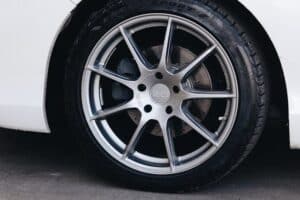In the realm of automotive maintenance, wheel repair stands as a crucial aspect that often goes overlooked. At 5 Star Tyres, we understand the significance of maintaining and restoring your vehicle’s wheels not only to preserve their aesthetic appeal but also to ensure optimal performance and safety. This comprehensive guide is tailored for DIY enthusiasts eager to undertake repair and restoration projects with confidence and success.
Understanding the Basics of Wheel Repair
Before diving into the complexities of wheel repair, it’s essential to grasp the basics. Wheels, being the point of contact between your vehicle and the road, are susceptible to a range of damages, from cosmetic scratches and scuffs to more severe issues like bends and cracks. Identifying the type of damage is the first step in the wheel repair process.
DIY Wheel Repair: Tools and Materials Needed
Embarking on a wheel repair project requires a set of tools and materials that are essential for achieving professional-grade results. These include:
- A high-quality wheel cleaner
- Sandpaper of varying grits
- A primer, paint, and clear coat specifically designed for alloy wheels
- A wheel repair kit for filling in deep scratches or cracks
- A tyre lever for removing and refitting the tyre
Step-by-Step Guide to Cosmetic Wheel Repair
Cleaning the Wheel: Begin by thoroughly cleaning the wheel with a dedicated wheel cleaner to remove all dirt, grime, and brake dust. This ensures a clean surface for the repair work.
Sanding Down Imperfections: Use sandpaper to smooth out any scratches or scuffs. Start with a coarse grit and gradually move to a finer grit for a smooth finish.
Applying Primer: Once the wheel is smooth, apply a coat of primer. This prepares the surface for painting and ensures better adhesion of the paint.
Painting the Wheel: Choose a paint that matches your wheel’s original colour. Apply in thin, even coats to avoid drips and runs. Allow each coat to dry thoroughly before applying the next.
Applying Clear Coat: The final step is to apply a clear coat over the painted area. This seals the paint, providing a protective layer against the elements and restoring the wheel’s glossy finish.
Addressing More Severe Wheel Damage
For damages beyond cosmetic issues, such as bends or cracks, professional assistance is often recommended. However, for those with a higher level of expertise, wheel repair kits are available that include materials to fill cracks or reshape the wheel. It’s crucial to assess the damage carefully; if the structural integrity of the wheel is compromised, replacement may be the safest option.
Preventative Measures for Wheel Maintenance
Prevention is always better than cure. Regularly cleaning your wheels and avoiding harsh driving conditions can significantly reduce the risk of damage. Additionally, investing in high-quality wheel protectors can offer an extra layer of defence against kerb damage.
Frequently Asked Questions!
1. Can I repair alloy wheels myself?
Yes, you can repair alloy wheels yourself, especially if the damage is cosmetic, such as small scratches or scuffs. For DIY enthusiasts, there are alloy repair kits available that come with all the necessary materials and instructions. However, for more severe damage, such as deep cracks or bends, it might be advisable to seek professional help to ensure the safety and integrity of the wheel.
2. What are the most common types of wheel damage?
The most common types of wheel damage include:
- Cosmetic damage: This includes scratches, scuffs, and chips on the surface of the wheel, often caused by kerbing or minor accidents.
- Corrosion: Wheels, especially alloy wheels, can suffer from corrosion due to exposure to road salts and moisture.
- Structural damage: This includes bends, cracks, or dents in the wheel, which can occur due to hitting potholes or severe kerbing. Structural damage requires immediate attention as it can affect the vehicle’s handling and safety.
3. How can I prevent wheel damage?
Preventing wheel damage involves a few simple practices:
- Drive carefully: Avoid hitting potholes and kerbs, and be mindful of road conditions.
- Regular cleaning: Keep your wheels clean from brake dust, road salts, and dirt, which can cause corrosion over time.
- Use wheel protectors: Consider using rim protectors, which can provide a barrier against kerb damage.
- Regular inspections: Check your wheels regularly for any signs of damage or wear and address issues promptly to prevent further deterioration.
Contact Us For Any Wheel Repair Needs!
Wheel repair and restoration can be a rewarding project for DIY enthusiasts, offering an opportunity to extend the life of your wheels while improving the overall look and safety of your vehicle. By following these detailed steps and employing patience and precision, you can achieve professional-quality results from the comfort of your own garage.
At 5 Star Tyres, we’re committed to empowering vehicle owners with the knowledge and resources to perform effective repair and maintenance. Remember, taking the time to care for your wheels not only enhances your vehicle’s appearance but also contributes to its longevity and performance.




